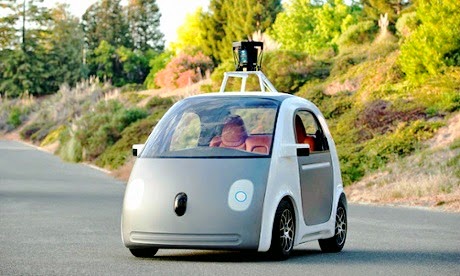For the past couple of years we have seen Google come up with outstanding projects which still seem unreal such as the Google smart shoes, Google diabetes lens and the list goes on. Among such products Google has started working on an even out of the way idea which is Google Self-Driving car. As it is obvious from the name that this car will drive itself but what is not obvious is that it gives the driver no steering wheel, brakes or accelerator.
The concept of this car was born from the Darpa Grand Challenge 2005 for robotic vehicles in which Sebastian Thrun, who is the current led for the Google car, and his team won for their robotic vehicle Stanley. Google started working on its own self-driving car project in 2008, and has been working on it ever since. In 2011, U.S. state of Nevada passed a law , permitting the operation of autonomous cars in Nevada and by 2012 Nevada Department of Motor Vehicles issued the first license for an autonomous car, Toyota Prius which was modified with Google's experimental driverless technology. Google than continued to experiment with customised Lexus SUVs, which took the car’s existing sensors, such as the cruise-control cameras, and added a spinning laser scanner on the top.
How Google Car Works
A Google robotic car costs about $150,000 which includes $70,000 lidar (light radar) system and is powered by an electric motor with around a 100 mile range. A Velodyn 64-beam laser is mounted on top of the vehicle as a range finder and it generates a detail 3D map of the world around the car, 360 degrees. These maps are then combined with high-resolution maps of the world to provide different types of data models that allows the car to drive itself. As of June 2014, the car uses high definition inch-precision maps of the area and can detect objects, people, cars, traffic signal and road works.
How to Drive Google Car
The car only has the capacity for two passengers. You can call the car by a smartphone for pick up from any user location with the destination set. As mentioned earlier there is no steering wheel or manual control, you just start the car by pressing the start button and can press a red button in case of an emergency. The passengers can view the weather and current speed on a small screen placed in front of them.
Once you have reached your desired destination you will see a message on the screen reminding you to take your personal belongings with you. This behaviour reinforces the fact that this car is more for a replacement of taxis without humans and not for personal use as of yet.
Until Now
After Google revealed its first prototype of the self-driving car, some people reacted negatively to the idea of having no steering wheel or brakes and having to rely on one red "panic" button in case of emergency. Meanwhile a Chinese search giant, Baidu revealed that they are also working on a concept that sounds like the Google self-driving car however a much more sensible version of it.
Baidu says that there car will be highly autonomous but it would let the driver operate and let them take control of the car anytime they want.
Google does plan to build a fleet of around 200 of these cars in Detroit with the hope of using them as an autonomous technology test bed. There are still debates going on, on how effect these cars will be keeping in mind the safely of the passengers.
References:
[1]http://www.theguardian.com/technology/2014/may/28/google-self-driving-car-how-does-it-work
[2]http://www.engadget.com/2014/07/25/chinas-baidu-to-challenge-google-with-its-own-self-driving-car/
[3] http://googleblog.blogspot.co.uk/2010/10/what-were-driving-at.html
[4] http://www.nytimes.com/2010/10/10/science/10google.html?_r=0

No comments:
Post a Comment